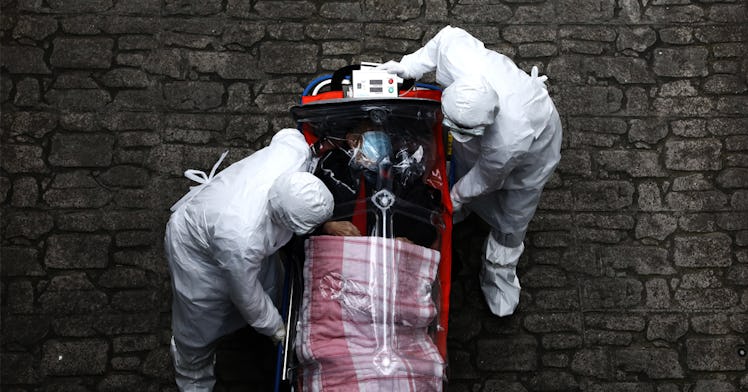10 Very Good Reasons We Should All Be Afraid of COVID
The coronavirus is scary, no matter what the President says.

President Trump, who returned to the White House after being hospitalized at Walter Reed Medical Center with COVID-19, says not to fear the coronavirus. “Don’t be afraid of COVID. Don’t let it dominate your life,” he tweeted on Monday. But just because the President has survived the disease doesn’t mean it’s okay to stop worrying about the pandemic. More than 210,000 people have died in the U.S. due to COVID-19, and that number isn’t going to stop climbing anytime soon.
Being afraid of the virus means taking it seriously. It means following precautions recommended by public health experts. It means wearing masks and not gathering in large groups. It means avoiding potential superspreader events. You know, like the superspreader event at the Rose Garden nomination ceremony for Amy Coney Barrett where President Trump may have been infected.
Being afraid of COVID-19 sucks, and no one wants your family to stay isolated at home for months on end. But an appropriate level of fear helps keep the virus in your mind when making decisions that affect your risk of exposure. If you need convincing, here are 10 reasons why you should keep worrying about the coronavirus.
1. It’s Deadlier than the Flu
After tweeting that you shouldn’t be afraid of the coronavirus, Trump followed up with another tweet saying that the flu is deadlier than COVID-19. This statement is false and has been removed by both Twitter and Facebook. Yes, the flu kills between 24,000 and 62,000 people in the U.S. every year, according to the Centers for Disease Control and Prevention. But since March, COVID-19 has already killed more than 210,000 people in the U.S., and many more deaths have probably gone uncounted.
2. COVID Is the Third Leading Cause of Death in U.S.
In 2020, COVID-19 will kill more people than anything but cancer and heart disease, according to the New York Times. This fact makes the flu comparison look even more ridiculous.
3. The Long-term Health Effects Are Real
It’s not just about deaths. Some people with COVID-19 have debilitating symptoms long after they should have recovered. Previously healthy, young people and other “long-haulers” still battle fatigue, lung damage, and other symptoms months after infection.
4. Heart Problems Are Common
The coronavirus doesn’t just attack the lungs. Previously healthy adults have developed heart failure after COVID-19, which possibly triggers heart inflammation. This inflammation has been detected in college athletes who have recovered from COVID-19, so it’s an issue for young people that may have to deal with the consequences for decades.
5. COVID Can Cause Neurological Damage
If the disease’s effects on the respiratory system, cardiovascular system, and gastrointestinal system weren’t enough, COVID-19 also can damage the brain. Stroke may be the first COVID-19 symptom in some patients younger than 50. And a third of all people hospitalized with COVID-19 experience some sort of altered mental state, whether that be confusion, unresponsiveness, or anything in between.
6. Multisystem Inflammatory Syndrome Targets Children and Adults
Though most kids who are infected by the coronavirus fare well, some come down with MIS-C. This condition, thought to be triggered by the body’s overreaction to the coronavirus, requires emergency hospitalization and invasive treatment. Though most treatment is successful, MIS-C can cause heart issues in children who may have not even had COVID-19 symptoms. And now the condition has been found to occur in adults (MIS-A) too.
7. It Is Not an Equal Opportunity Virus
People of color, particularly Black people, Latinos, and Native Americans, face a disproportionate burden of COVID-19 cases and deaths. These numbers, like so many others, reflect the hard realities of racism in the U.S., including barriers of access to medical care and testing, an increased prevalence of underlying health conditions, and a lack of insurance coverage.
8. Airborne Transmission Is Bad News
The Centers for Disease Control and Prevention acknowledged on Monday that the coronavirus is partially spread through airborne transmission. This means the virus can hang suspended in the air for hours, and people can be infected by inhaling virus particles in the air. That’s bad news. Though social distancing decreases risk of transmission by droplets in close contact, it’s not enough to stay safe. Even if the gym seems empty, you could still get infected in it if someone was using the same treadmill before you an hour ago.
9. Mental Health Effects Are Common
Anxiety and depression levels have spiked during the pandemic, in part due to feelings of isolation and loneliness — not to mention that people are reporting chronic stress, insomnia, and economic instability. Increased numbers of suicide may follow. (This is a good reminder that while you should take COVID-19 seriously, you should also seek help if you’re experiencing extreme fear and anxiety or other symptoms of mental illness.)
10. It’s Not Going Away Anytime Soon
Although experts disagree on just how long the pandemic will last, there is consensus that it’s here to stay for quite some time. Years, probably. At least months. Will it ever fade to the backburner? Experts aren’t sure. It could become seasonal, like the flu. It could make an appearance every other year. That will depend in part on how long immunity lasts from a vaccine, and experts aren’t sure how long that will be. And that leads us to a final thing to be afraid of: uncertainty.
This article was originally published on